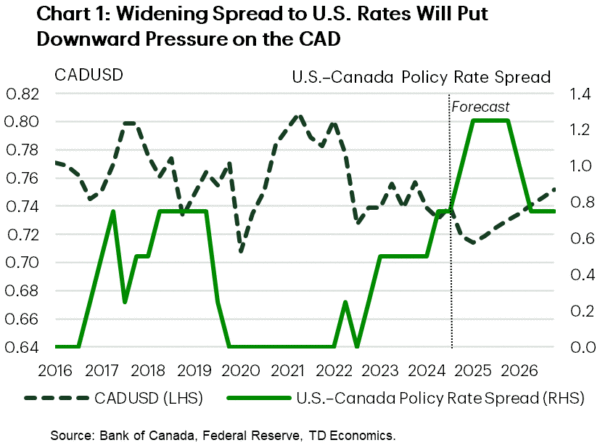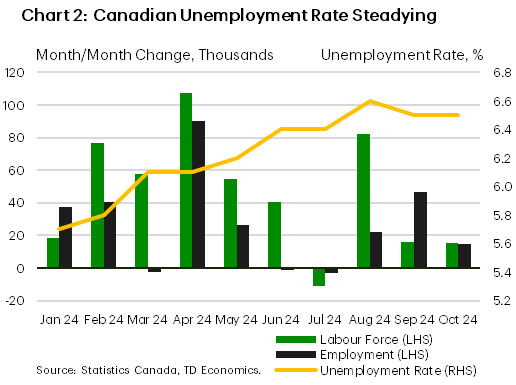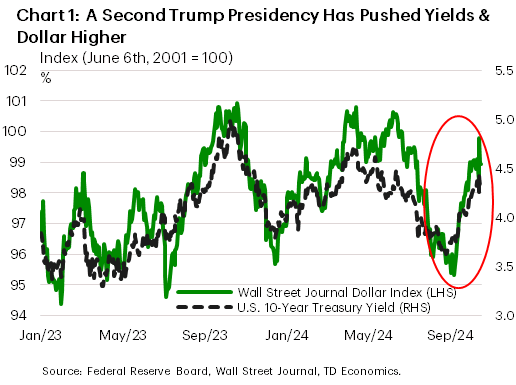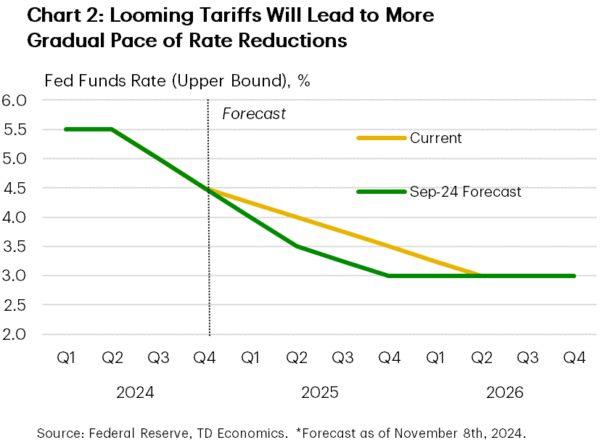Canadian Highlights
- Donald Trump’s election victory means heightened macroeconomic uncertainty north of the border.
- Canada’s labour market put in a decent showing in October as the unemployment rate steadied, while job creation continues.
- A hefty increase in preliminary housing sales data for October may be proof that interest rate cuts are beginning to boost housing market activity.
U.S. Highlights
- President-elect Donald Trump will serve as the 47th president of the United States, securing 295 of the 538 Electoral College votes.
- Republicans also gained control of the Senate, while the House of Representatives is still up for grabs. Odds favor the Republicans maintaining control of the House, though 25 seats have yet to be called.
- The Federal Reserve delivered on a quarter-point rate cut this week, and kept the door open to further cuts in the months ahead.
Canada – With Certainty Comes Uncertainty
In case you missed it, there was a U.S. election this week! Former President Trump will return to the White House come January. With that, the degree to which his policies will impact Canada’s economy will be a lingering question for months to come. We have gathered our initial thoughts on the economic impacts here. In the aftermath of the results, Canada’s 10-year yield spiked nearly 20 basis points (bps) to over 3.40% but has fully retraced at the time of writing. The CAD finished flat on the week (0.719 cents) despite heightened volatility, while Canadian stocks caught a bid, rising 2.5%.
A big near-term question is how Trump’s tariff policy will jolt U.S.–Canadian trade relations. Our recent research details our expectations related to the future state of trade. In short, the existing USMCA trade agreement with the U.S. (and Mexico) could keep Canada insulated from tariffs, so long as we make a handful of concessions come the pact’s review in 2026. That said, we do not discount the very real risk that Trump could move forward with tariffs on Canada, which would have immediate negative impacts on GDP, inflation, and trade.
Trump’s presidency also puts the Canadian dollar on a different path. Our forecast for higher U.S. inflation will result in a slower pace of U.S. rate cuts in 2025, widening the spread between the Bank of Canada and the Fed, and pressuring the loonie lower (Chart 1). The Canadian dollar has already depreciated around 3% against the Dollar since early-September, and we expect the CAD will bottom in Q1-2025 before modestly appreciating thereafter. It would not surprise us to see the CAD temporarily break below 70 cents in the near-term.
The election overshadowed some important domestic developments. For one, Canada’s job market looks to be on solid footing. Canada’s economy has added a respectable 270k jobs so far this year, 15k of which came in October. Against this backdrop, we are seeing the unemployment topping out around current levels (Chart 2), as the federal government’s plan to aggressively slow population growth should limit the buildup of further labour market slack. Meanwhile, wages continue to show signs of stickiness and a jump in hours worked suggests October GDP growth could print a solid number.
Elsewhere in the Canadian economy, housing markets may finally be responding to rate cuts. Preliminary sales data for October are consistent with a hefty 8% increase in home sales based on double digit surges in Toronto and Vancouver sales activity. With additional interest rate cuts on the way and new federal borrowing measures, more momentum is likely to build.
For now, the Bank of Canada’s (BoC) best approach would be to look through the near-term uncertainties when setting the policy rate. It is still too early to have a high-conviction call for the December 11th meeting given the deluge of data between now and then, but we do think that the Bank will revert back to a 25 bps cut after opting for a 50 bps jumbo move last month.
U.S. – Trump Victory Likely to Bring Big Policy Changes
U.S. equities surged higher this week following Donald Trump’s decisive victory in the presidential election. Longer-term Treasury yields also shot higher, but later retraced all of Wednesday’s Trump trade as the Federal Reserve helped to calm the bond market by delivering on a quarter-point rate cut. The S&P 500 ended the week 4% higher and is now up an impressive 25% year-to-date. Meanwhile, the 10-year Treasury yield is looking to the end week slightly lower at 4.32% but is up nearly 60 basis points (bps) over the past month. (Chart 1).
Beyond winning the White House, the Republicans also took control of Senate, securing 53 of the 100 seats as of writing. Two races are still too close to call, so there’s potential for the GOP’s majority to widen a bit more once all the ballots are counted. Meanwhile, control for the House of Representatives remains up in the air, with 25 seats still to be called. At this point, odds heavily favor the Republicans maintaining control of the House, but it’s unclear whether the GOP will be able to make further inroads relative to their current slim majority of four. If the GOP retains only a slim majority in the House, President Trump will need near-unanimous GOP support to pass legislation, which could present some challenge to his agenda.
One thing is for certain under Trump 2.0: tariffs are coming. Once sworn in on January 20th, we expect Trump to use executive powers to act quickly and levy sweeping tariffs on many of the U.S.’s trading partners. China is at the top of the list, but history has shown that Trump isn’t afraid to raise tariffs on allies. While it is possible that Canada and Mexico receive some carve-outs, it would likely be conditional on them following the U.S.’s lead and leveraging similar tariffs on China. Others may also negotiate concessions, but that isn’t likely to happen until after the tariffs are in play.
No matter which way you slice it, the more protectionist trade measures will be inflationary and work against the Federal Reserve’s objective of restoring 2% inflation. At the press conference, Chair Powell acknowledged this point, but also noted that the Fed doesn’t adjust its policy rate to potential changes in fiscal or other government policies. For now, the FOMC remains highly data dependent. This puts next week’s inflation report in focus, particularly after the September reading came in hotter than expected. With the economic data still strong, any further signs of stickiness on the inflation front will likely push Fed officials away from continued quarter-point cuts and towards a slower rate cut trajectory.
At this point, we still feel that a December rate cut is still likely. However, we’ve revised our forecast for next year, reflecting the fact that tariffs (and the potential for tax cuts) will result in more persistent inflationary pressures. We now assume the Fed takes a more gradual approach in reducing the policy rate in 2025, cutting at every-other meeting, resulting in a total of 100 bps of easing by year-end (Chart 2).

















